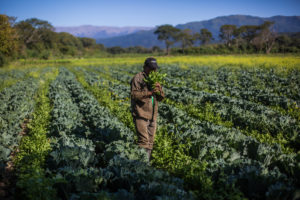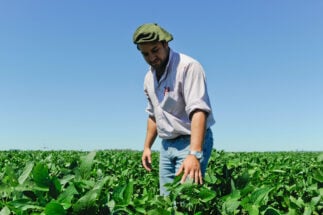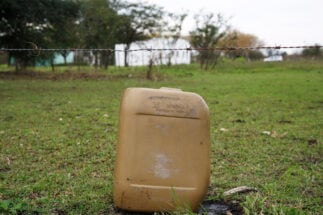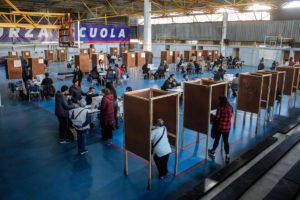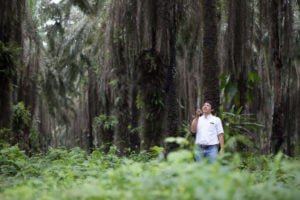On 19 December last year, at the COP15 summit in Canada, 195 countries reached an agreement to work together to reverse the loss of biodiversity. One million of the world’s 8 million known animal and plant species are threatened with extinction, and the summit recognised the importance of tackling factors such as land use and overexploitation, as well as climate change.
One commitment sealed at the summit was to reduce by half, by the end of this decade, the excess nutrients produced when fertilisers are used in greater quantities than crops can absorb, and to at least halve the “overall risk” from pesticides and highly hazardous chemicals.
Achieving this would imply a substantive change in the global agricultural and food system, which is characterised by strong imbalances between producer and consumer nations. Much conventional agriculture depends on large monocultures, often involving genetically modified crops engineered by the same countries that produce pesticides. These are particularly harmful to biodiversity, especially when forests and other natural ecosystems are cleared to make way for cropland.

As an alternative, agroecological practices seek to avoid overexploitation of the soil, focus on native varieties rooted in local knowledge, and minimise or eliminate the use of synthetic products in favour of bio-inputs, which allow the control of pests and diseases from microorganisms, fungi, minerals or plant derivatives.
“The first year is more difficult; many times the soil is dead because of the use of chemicals,” says Ítalo Choque Baldiviezo, a member of the Union of Land Workers (UTT), an association of more than 20,000 small farmers from Argentina.
“But from the second year on, when the microorganisms give it life, the products become more robust and with higher yields. An ecosystem appears in your field: fertiliser, flowers and biodiversity increase. You don’t need so much work anymore, just to rotate the crops.”
An unbalanced model
Half of the pesticides used globally are herbicides, which combat weeds, 30% are insecticides and 17% are fungicides. A good portion of them “deteriorate human health, biodiversity, water and soil”, according to the Pesticide Atlas 2022, a report that also points out how major companies such as Bayer, BASF and Syngenta are allowed to export products that are banned in their own territories. In fact, four of the 10 most used pesticides in Brazil cannot legally be marketed in Europe. While 468,000 tonnes of synthetic products were used in Europe in 2020, a reduction of 0.2% compared to 1999, South America used 770,000 tonnes, an increase of 119% over the same period.
Among the most sold pesticide products are: glyphosate, said to be “probably carcinogenic” by the World Health Organization, though this is disputed; paraquat, found to be highly toxic in humans; atrazine, a hormone disruptor; and neonicotinoids, which are toxic to bees. Effects of exposure to these substances include rashes and burning eyes, fatigue, headaches and body aches. As the active ingredients are often spilled on soil, run off into water or are sprayed into the air, they also find their way into food.
More persistent cases of poisoning can lead to heart, lung or kidney failure, and chronic diseases such as Parkinson’s disease or childhood leukaemia, the Pesticide Atlas reports. Their compounds have also been associated with liver and breast cancers, diabetes, asthma, allergies, premature births and growth disorders.
Every year 385 million people fall ill from pesticide contamination, 95% of them in the southern hemisphere, according to the Atlas. Despite this, applications persist in South America at any time of the day and under any weather conditions, regardless of the use of water resources and the minimum distances to homes and schools – much of this done with the lucrative export market as the focus. A report by Brazilian human rights organisation FIAN claims that in Paraguay “the agro-export sector enjoys absolute impunity” thanks to collusion with government agencies, promoters of a model in which 94% of cultivated areas are used for export while 70% of the country’s food is imported.
The imbalances resulting from the advance of monocultures also include the emergence of weeds and insects resistant to agrochemicals – in turn creating a need for new generations of seeds and more intensive use of pesticides. Deforestation also leads to the loss of birds, butterflies and bees, all crucial pollinators of ecosystems.
The belief that pesticides are indispensable for agriculture, as well as the lack of a coordinated determination to move towards alternative models, has led to hunger, malnutrition and food contamination in Latin America, according to FIAN. The group also highlights the homogenisation of the food supply. This last issue “should not only be considered from the supply side but also from the demand side,” says Claudio Dunan, strategy director for the Bioceres Group, which was authorised to commercialise the world’s first transgenic wheat in Argentina. “Just as there is an overuse of fertilisers, there is an overconsumption of proteins, although poor countries consume much less than those with high purchasing power.” People in the United States and Europe, for example, eat much more than the recommended 50 grams of meat per day.
We continue to have a high dependence on chemical products. It is not easy to replace the high amounts of nutrients needed by crops with other forms of managementClaudio Dunan, Bioceres Group
Even so, he believes that the COP15 goals can only be achieved gradually, so as not to jeopardise world food security: “We continue to have a high dependence on chemical products. It is not easy to replace the high amounts of nutrients needed by crops with other forms of management. In fact, it is necessary to produce more per hectare in order for deforestation to not advance further.”
The agroecological path
Limiting the damaging capacity of pesticides by reinforcing actions to monitor and control their use is only part of the solution. In the transition to a more sustainable model, agroecology appears a promising option.
In Brazil, the Associated Group for Sustainable Agriculture (GAAS) promotes the production of bio-inputs through a network that brings together soybean and corn producers with experts in sustainable management. “Fungi and bacteria that help control pests multiply on farms to replace pesticides,” says GAAS scientific-technical collaborator Pablo Hardoim.
Its 700 members, covering more than three million hectares, work with micro-organisms, a mix of ground cover plants and “rock dust”, a mineraliser that replenishes nutrients and rejuvenates old soils. Thanks to these management practices, the use of synthetic fertilisers has been reduced by 60 per cent among the members and costs have fallen by about a third.
Hardoim acknowledges that it is difficult to replace synthetic products in no-till crops, although he points out that “many times we can do agriculture without them [by using] tools that are less harmful to the environment. It will not necessarily be possible to feed the world, but the production of coffee or citrus can be equal or greater without industrial alternatives.”

In Argentina, UTT brings together families that produce agroecological fruits, vegetables, grains and dairy products. It runs a “technical clinic” that is involved in the production and management of inputs, supported by technical advisors who belong to producer families themselves.
To prepare the plots, they start with bokashi, a fertiliser produced by fermentation that accelerates the degradation of organic matter and raises the temperature, eliminating pathogens. “It uses dung, molasses and charcoal. We can make from 50 kilos to one tonne,” says Ítalo Choque Baldiviezo. Then biofertilisers are prepared, through a process in which bacteria reproduce in manure to obtain the microorganisms that will nourish the crops.
“A tomato produced with industrial fertilisers can be radiant, but it tastes like plastic,” says Baldiviezo. “Although they don’t shine, those from agroecology have flavour and texture.” His methods can also be applied to extensive systems, he says, based on successful tests with corn and wheat, to which they applied a fungicide and their own insect control. The harvest was then sold to a local food factory.
Uruguay is also advancing towards bio-inputs – products that are “a line towards the future that is developing at an increasingly rapid pace,” as Sebastián Viroga, national coordinator of the Pesticides Project of the United Nations Food and Agriculture Organization, told Diálogo Chino last year. Among their innovations, created with government and international support, are wasp “capsules” that help against soybean pests, and a product based on fungi to combat leaf-cutter ants, which are capable of generating grass losses equivalent to the consumption of a calf.
“Everything we collected from producers had a positive impact,” Viroga explains. “Small and medium-scale farms have reported more impacts than in extensive agriculture, but in almost all cases the results were equally or more effective than with synthetic products.”
The issue also appears to be advancing in the political sphere. Deputies in Uruguay have put forward a bill to achieve agricultural management with “ecologically safe, hygienically acceptable and economically feasible” methods, which includes the use of bio-inputs.
The risks of the middle ground
While praising these experiences in South America, a paper by CIRAD, a French agronomic research organisation, warns that bio-inputs do not imply a decision to abandon industrial agriculture models, from which countries receive high export revenues. Mixed approaches continue to be used both by producers seeking to move towards agroecology and by companies diversifying their portfolios by incorporating bio-inputs.
The latter, suggests Hardoim of GAAS in Brazil, is part of a change in the strategy of large agricultural consortiums. These companies are moving from being mere sellers of products to providers of services such as agriculture with drones or artificial intelligence applications, which, in addition to increasing crop efficiency, are promoted as more sustainable methods.
Although this appears to align with the tenth goal agreed at COP15 – to manage agriculture through the sustainable use of biological diversity – this new strategy does not imply the same thing at both ends of the production system. While the partial incorporation of bio-inputs can be seen as a response to the growing demands of European countries to control the quality of their value chains, a failed or incomplete transition in South American ecosystems could end up embodying all the fears expressed in Montreal.
